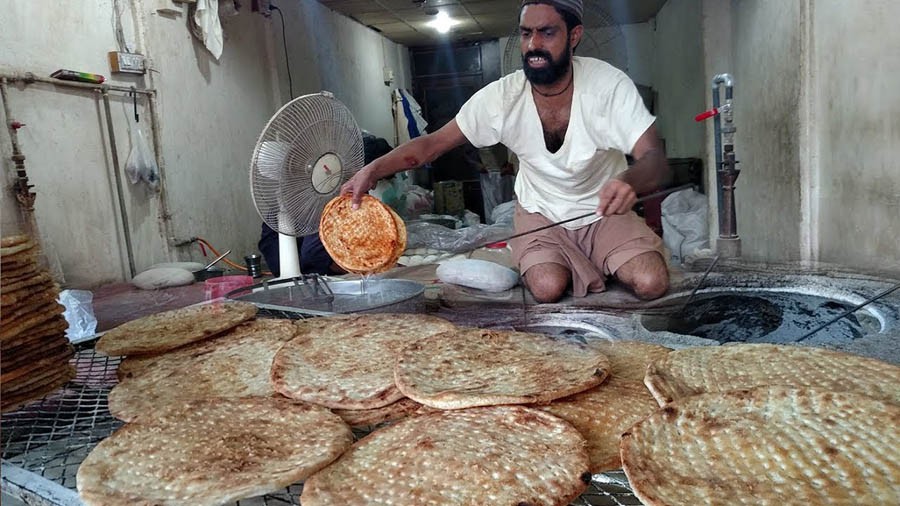
Tandoors have blatantly disregarded the directives of Prime Minister Imran Khan to return to pre-increment prices of roti

Over the last 12 months, Pakistan has endured significant increases in the cost of economic inputs. Leading to devastating price hikes for all essential food items, including common staples such as naan and chapati which are typically produced in local tandoors. The upshot being that along with the poor, the middle-class is now also struggling. The government stands accused of losing its writ on price control.
There are additional contentions, such as the absence of quality and quantity checks, despite necessary regulations being in place. Consider that last year, when prices were stable, the nanbais were already contravening the directives of all district administrations that had placed bread weight at 120-150 grams. Instead, they were supplying just 90-100 grams, meaning that consumers were paying 20-30 percent above the actual market price.
The first signs of discord appeared back in December 2018 when flour mill owners accused wheat suppliers of unilaterally raising prices. This, combined with hikes in transportation costs (a knock-on effect of increased petrol rates) and electricity and gas tariffs, forced the tandoors to follow suit. Last month saw naan and roti rates almost doubling. This was justified on the grounds that gas tariffs continue to increase. The Punjab also suffered a shortfall in wheat production; thereby pushing up wheat flour prices.
The Finance Bill (2019-2020) only added to the confusion. Initially, stipulating that milling products were subject to sales tax. This prompted an upward surge in wheat flour prices. Yet the subsequent clarification that this would not be the case offered little relief. Flour mills undertook a smaller downward revision in rates; arguing that the initial hike covered other input factors.
An overview of the economics of naan and roti production finds that 100kg of fine wheat flour yields 830 naan of 120 grams each. Market rates for the flour fluctuate between Rs40-56 per kg -- or Rs4,000-5,600 per 100kg. Following is a breakdown: the cost of basic raw materials come in at Rs4.82-6.78 per 120 grams. Additives like yeast and curd (for naan) add another Rs2 per piece. Daily labour rates for naan are Rs2,400 (Rs1,500 for the master baker and Rs900 for an assistant). Between them, they produce 2,000 naans or rotis per day. Thus, labour as a means of production costs an additional Rs1.20. Then there is fuel expenditure, ranging from Rs1 for gas-run tandoor or Rs1.5 for LPG (liquefied petroleum gas) or other fuel-operated tandoors. All of which brings the total cost to Rs10.50-12.50 per naan. A margin of five percent for wastage pushes up prices further. Regarding roti, ‘overheads’ are lower given that half the labour and fuel costs are required.
Since it is impossible for a tandoor owner to sell a 120-gram naan even at Rs15 -- the flour quantity is routinely reduced to 90 grams, incurring a 30 percent saving on basic raw materials. Average rates for roti currently are: Rs7 for a regular roti, Rs10 for a khamiri roti and Rs12-15 for a naan.
Thus, tandoors have blatantly disregarded the directives of Prime Minister Imran Khan to return to pre-increment prices. And even though the Centre eventually exempted tandoors from gas hikes -- not all are run on government-supplied fuel. Some, for example, use LPG or else wood and coal. Thereby rendering the cost of production unchanged. Moreover, in such cases, it becomes unfeasible to lower rates as this would mean decreasing the weight of roti and naan; a last resort in the face of administration pressure.
All of this is bad news for the country’s poor. In fact, 90 percent of the citizenry rely on roti or naan as the mainstay of their diet. Therefore, the question of paying a few more rupees here or there is more than a matter of loose change. Labourers are forced to curtail consumption due to lack of financial resources. This risks output. For although wheat flour is not a complete food -- it does provide essential energy.
The per capita annual wheat consumption in Pakistan is 110kg for adults. Out of a population of around 207 million, some 67 million are in employment mostly as low-paid labour or daily-wage earners. Eighty percent of whom buy roti or naan from tandoors on a daily basis at lunchtime. Migrant workers will also look to tandoors for the evening meal. Winter months punctuated by gas loadshedding and long hot summers nudge entire households into venturing to these vendors who eat up almost 30 percent of national wheat supplies. The cheap cost of capital offset by a guaranteed high return and makes this a low-risk business model and contributes to the difficulty in regulating tandoors.
Given the sheer volume of demand, the market economy dictates that prices must drop. But with all eyes on profit margins, many tandoors are opting for diversification. Thus offering special items, such as paratha, roghni or keema naan pave the way for increased rates. Yet, with a varied menu comes the burden of different recipe considerations. For instance, the Indian flatbread kulcha, while similar to naan, is made from refined white flour and leavened with yeast or old kulcha dough whereas yogurt provides the same function for naan.
Tandoori naan culture has long been something of a great equaliser, cutting across all class divides. This is how it has survived the arrival of new dhabas and cafes that are forever springing up around the cities. All the more regrettable, therefore, that a haemorrhaging economy jeopardises this.